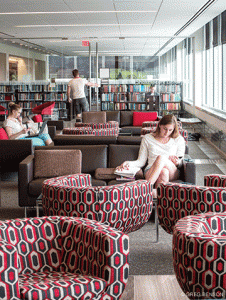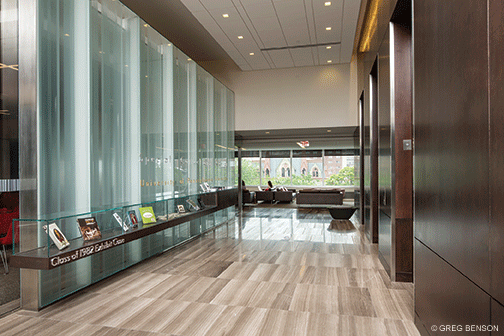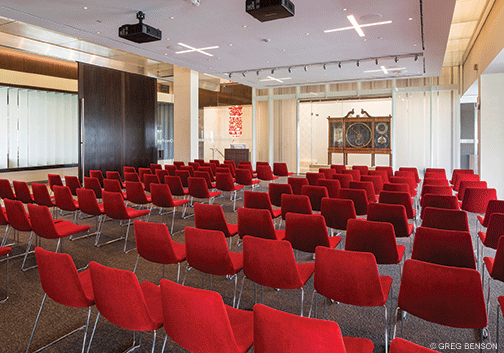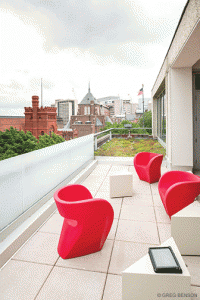
On April 18, visitors to Van Pelt Library were able to do something they’d been denied for nearly three years: take an elevator all the way to the top. And when the doors first slid open on the new sixth-floor Special Collections Center, word started traveling fast about the University’s mod makeover of the Rare Book and Manuscript Library, which closed in 2010 for renovations. By the time final exams rolled around, the light-splashed lounge area, occupying what had previously been a little-used terrace facing College Hall, had become prime real estate.
“During finals,” as one undergrad put it a few weeks later on the ride up to the top, “you had to get here early to get a seat.”
It’s not hard to see why. The Special Collections Center—which comprises the Rare Book and Manuscript Library, the Furness Memorial Shakespeare Library, the Edgar Fahs Smith Memorial Collection, and the Schoenberg Institute for Manuscript Studies—is a sparkling communion of centuries-old artifacts and Mad Men-era modernism. Light shimmers on the creamy grain of Canadian marble floor tiles, and seeps through floor-to-ceiling panels of clear and frosted glass. Here’s Benjamin Franklin’s mahogany writing desk, marking the entrance to the (unchanged) Henry Charles Lea Library, in all its burnished, archaic splendor. There, visible through a translucent glass cube enclosing the Class of 1978 Orrery Pavilion, is the star-spangled dial of David Rittenhouse’s exquisitely geared representation of the solar system as far out as Saturn—an instrument older than the Republic.

“Penn was founded for the propagation of useful knowledge, without a church on campus,” notes William Noel, director of the Special Collections Center and Schoenberg Institute for Manuscript Studies. And the SCC’s new home, he adds, “makes you feel like you’re in a very high-class, ritzy hotel, which has the Rittenhouse Orrery as its altar. It feels like a modern temple to a field that’s being transformed in the 21st century.”
The physical transformation of Van Pelt’s top floor has been a long time coming, according to H. Carton Rogers III, vice provost and director of libraries. In his estimation, the old layout seemed to maximize inconvenience and interruption, with a floor plan that wasn’t flexible enough to accommodate more than one sort of activity at a time.
“We had these libraries that were theoretically both independent and working in a collegial way, but the floor itself didn’t gel,” Rogers says.
“If you wanted to get to the controlled reading room,” he recalls, “there’d be some event going—and there’d be this lonely page rolling his or her squeaky trolley right through the middle of the event, retrieving material for some scholar who has had to fight his or her way through the audience.”

By contrast, the new Class of 1978 Orrery Pavilion, which seats about 100 people, can be closed off without restricting the comings and goings to either the refurbished reading room—which now features three small conference rooms where scholars can collaborate without perturbing the silence—the digital media lab, or a trio of seminar rooms separated by retractable wall panels. The new floor plan also contains the Goldstein Family Gallery, a small, museum-grade exhibition space where manuscripts can be displayed in a setting protected from ultraviolet sunlight.
 “What drove the space was the use,” Rogers says. “We were already seeing these incredible opportunities—we were being asked by faculty, ‘I’d love to have my class up on the sixth floor, can you provide a teaching space for me? I want to integrate the use of materials from your collection into my courses, right there.’ So this is all of a piece. The space serves the community, but the community has driven the [renovations] by their academic and research interests.”
“What drove the space was the use,” Rogers says. “We were already seeing these incredible opportunities—we were being asked by faculty, ‘I’d love to have my class up on the sixth floor, can you provide a teaching space for me? I want to integrate the use of materials from your collection into my courses, right there.’ So this is all of a piece. The space serves the community, but the community has driven the [renovations] by their academic and research interests.”
Noel doesn’t expect that the stylish digs will necessarily spur more visits from scholars. “The scholarly world isn’t put off by ugly buildings,” he notes. “So the research profile hasn’t changed very much. It will only change with the growth of the collections”—which both he and Rogers expect, especially with the completion of a state-of-the-art conservation laboratory (on the fifth floor) next year.
“The real change,” Noel adds, “ will be in the visibility of the collections for the undergraduates and graduate community, and their ability to work with these materials in their daily life, in a setting that’s frankly pretty amazing.” —T.P.

